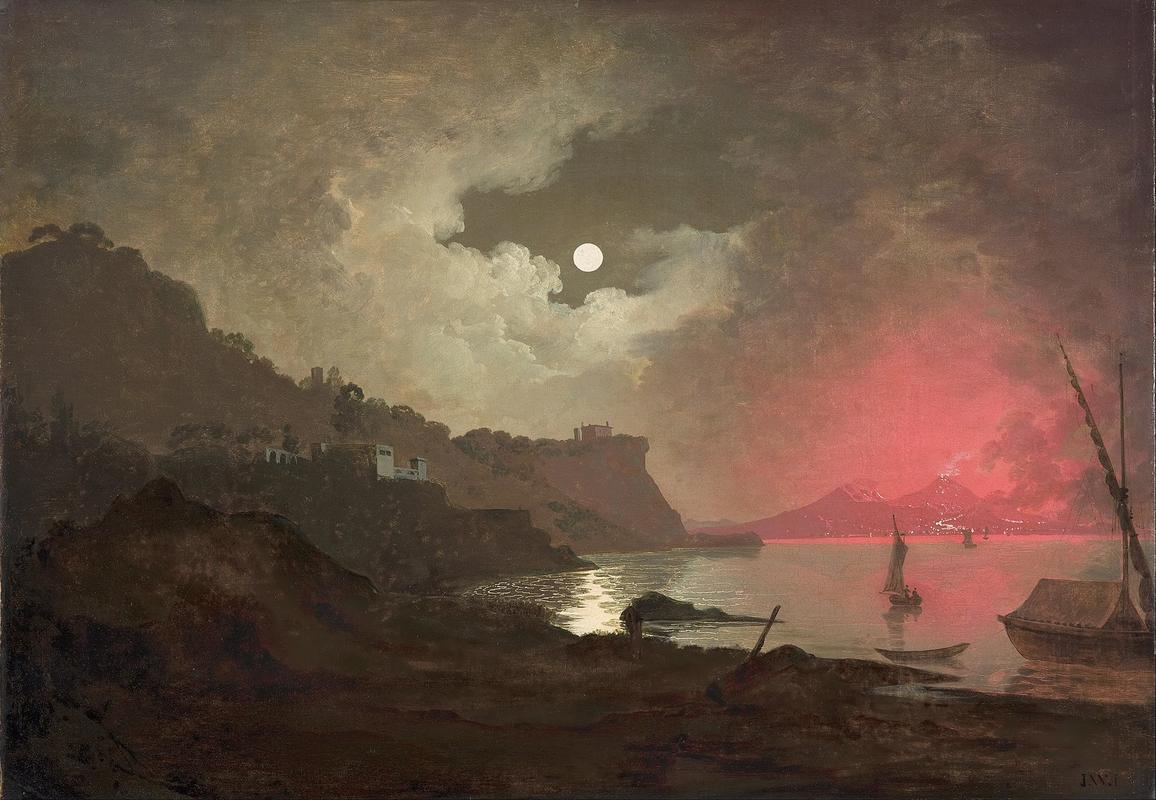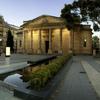More about A view of Vesuvius from Posillipo, Naples

Contributor
A View of Vesuvius from Posillipo, Naples, one of Wright's majestic series of portrayals of the great volcano, reminds us that some things are so inevitable, so terrifying, so dangerous, so grandiose in their level of existential threat, that - we almost always ignore them.
The poor souls who perished in the eruption of Vesuvius 4,000 years ago, which obliterated the entire Naples Bay region, and even the Roman folks who tried in vain to run from the wrath of Mother Earth in the settlements of Pompeii and Herculaneum in the year 79 CE, had no idea that there was a scientific connection between the shifting of the tectonic plates, the frequency and ferocity of earthquakes, pumice raining down like frogs in the movie Magnolia, and pools of flaming red liquid devouring everything they loved. They had good excuses not to have any evacuation plan, partly because they would have felt that the earthquakes were the result of the wrath of Poseidon, which, like a jury summons, you can't escape, anyway. This work is one of at least six views of Vesuvius from Posillipo by Wright, according to historical documents. In all, Wright painted thirty views of Vesuvius, one of which became an engraving in 1788.
By the era of the revolutions in France, Haiti and North America, when Wright composed A view of Vesuvius from Posillipo, Naples, Europe knew that Vesuvius had erupted way back in the days of the Empire, but they'd lost track of where, exactly, the settlements were, as many of them were, and still are, buried under layers of geological material connected to the eruptions. Simultaneously, a huge debate raged, and still rages, over the "Celebrity Deathmatch" of "Religion vs. Science," which, despite the falseness of opposing religion and science as though they don't already overlap and cannot bear any fruit by working in unison, managed to create lots of chaos in Europe. It was all connected with the French guillotining the aristocrats and brutally inaugurating a new era of thinking about the world.
One of the bastions of radical science was the Lunar Society of Birmingham, through which Wright met his close friend, Erasmus Darwin, Charles' grandpa, who Wright would paint in a portrait about two years after he finished this work. Darwin and Wright were so close that Darwin treated Wright for anxiety and respiratory issues when he returned to Derby, where Wright painted A view of Vesuvius from Posillipo, Naples. A year after the Darwin portrait, a mob (an angry one, that is) busted up the laboratory of another Lunar Society member, Joseph Priestly, who called for "laying gunpowder" under the "superstitious" idea that Poseidon, or any other supernatural Being, could will Vesuvius to erupt, as it had done before Wright's eyes when he visited. The great man of letters Edmund Burke presciently predicted that the outsourcing of ideas from physics, math and chemistry to human relationships was not too great of an idea. In other words, the world might not be a great big computer, and maybe we aren't just robots without souls, or, as Burke put it, "These philosophers consider men, in their experiments, no more than they do mice in an air pump, or in a recipient of mephitic gas." Burke's "air pump" reference may as well have been a direct nod, or finger wag, at Wright's most famous work, from a few decades earlier.
Of course, the idea that there could be some all-knowing divine being allied with Mother Earth, making the tectonic plates ooze their noxious magma and making the newly-revealed laws of physics operate in all their intricacy, is a compelling one. Although he was close with Darwin, it's not entirely clear to me that Wright himself took Priestly's side in the Burke beef. In fact, Wright saw a divine and incommensurable, unspeakable greatness in the volcano. As grandpa Darwin wrote of his friend in his scientific epic poem, The Botanic Garden:
"So Wright's bold pencil from Vesuvio's height
Hurls his red lavas to the troubled night;
From Calpe starts the intolerable flash,
Skies burst in flames, and blazing oceans dash."
Sources
- Barnard, Teresa. British Women and the Intellectual World in the Long Eighteenth Century. London: Routledge, 2016.
- Burke, Edmund. "Letter to a Noble Lord." 1795-96, https://web.archive.org/web/20110520081802/http://ourcivilisation.com/s….
- Daniels, Stephen. Joseph Wright. London: Tate Gallery Publishing, 1999.
- Darwin, Erasmus. The Botanic Garden: A Poem in Two Parts Containing The Economy of Vegetation and The Loves of the Plants, with Philosophical Notes : Also The Temple of Nature, a Poem. London: Jones & Company, 1825.
- Jashemski, Wilhelmina Feemster, and Frederick G. Meyer. The Natural History of Pompeii. Cambridge: Cambridge University Press, 2002.
- McCalman, Iain. An Oxford Companion to the Romantic Age. Oxford: Oxford University Press, 1999.
- Watson, Ross. Joseph Wright of Derby: A Selection of Paintings from the Collection of Mr. and Mrs. Paul Mellon. [Exhibition] November 22, 1969 to May 1, 1970. Washington, D.C.: National Gallery of Art, 1970.











